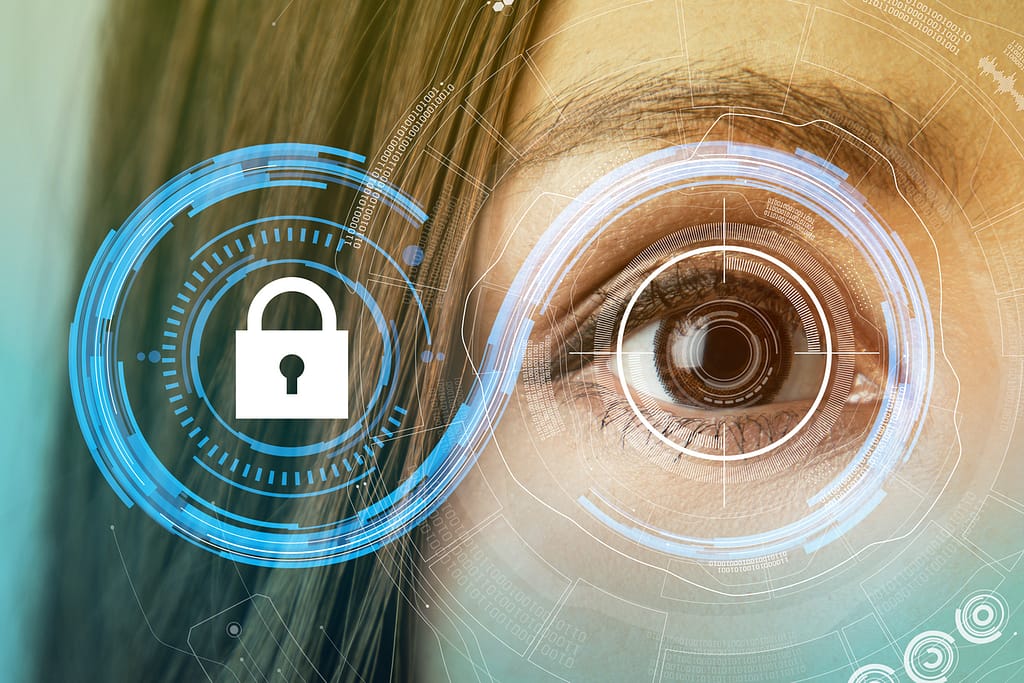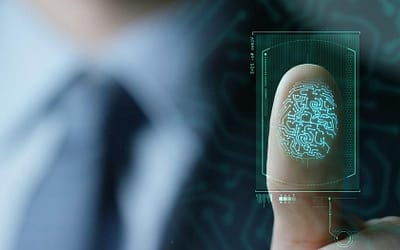How iris recognition works

If you hate having to carry a jangling bunch of jailer’s keys wherever you go, imagine how cool it would be if you could unlock your door just by staring at it for a couple of seconds! Iris scanning technology could soon make this kind of thing completely routine. It’s already being used in airports and military bases where fast, reliable identification is vitally important. Iris scans are the most accurate form of biometrics (identity checking based on sophisticated body measurements)—far superior as a form of identification to fingerprints (which can wear out in time) or DNA profiling (which isn’t instant). What exactly are iris scans and how do they work? Let’s take a closer look!
Why use biometrics?
There are more people on Earth than ever before, owning more things, and swapping more information every single day. Security has never been more important but—ironically, thanks to the computing power at everyone’s disposal—never easier to crack. Traditionally, security relies on things that are difficult to do quickly: locks are physically difficult to bust open without the correct metal keys, while information secured by encryption (computerized scrambling) is hard to access without the right mathematical keys. But this kind of security has a basic flaw: with the right key, even the wrong person can quickly gain access.
Most security experts think biometrics (body measurement) is the answer. Instead of restricting access to things through arbitrary locks and keys, we grant access to people if we can positively identify them by measuring some unique pattern on their body. If you think about it, an ordinary passport photo is a crude example of biometrics. When the border guards look at your face and compare it with your passport photo, what they’re doing is intuitively comparing two images. Is one nose bigger than another? Are the eyes further apart? That’s simple biometrics. The trouble is that our faces change all the time and lots of people look very similar. Fingerprints are a more reliable form of biometrics,
What makes an iris scan unique?
The iris is the colored ring of muscle that opens and shuts the pupil of the eye like a camera shutter. The colored pattern of our irises is determined genetically when we’re in the womb but not fully formed until we’re aged about two. It comes from a pigment called melanin—more melanin gives you browner eyes and less produces bluer eyes. Although we talk about people having “blue eyes,” “green eyes,” “brown eyes,” or whatever, in reality the color and pattern of people’s eyes is extremely complex and completely unique: the patterns of one person’s two eyes are quite different from each other and even genetically identical twins have different iris patterns.
How does iris scanning work in practice?
To get past an iris-scanning system, the unique pattern of your eye has to be recognized so you can be positively identified. That means there have to be two distinct stages involved in iris-scanning: enrollment (the first time you use the system, when it learns to recognize you) and verification/recognition (where you’re checked on subsequent occasions)
Enrollment
First, all the people the system needs to know about have to have their eyes scanned. This one-off process is called enrollment. Each person stands in front of a camera and has their eyes digitally photographed with both ordinary light and invisible infrared (a type of light used in night vision systems that has a slightly longer wavelength than ordinary red light). In iris recognition, infrared helps to show up the unique features of darkly colored eyes that do not stand out clearly in ordinary light. These two digital photographs are then analyzed by a computer that removes unnecessary details (such as eyelashes) and identifies around 240 unique features (about five times more “points of comparison” as fingerprint systems use). These features, unique to every eye, are turned into a simple, 512-digit number called an IrisCode® that is stored, alongside your name and other details, in a computer database. The enrollment process is completely automatic and usually takes no more than a couple of minutes.
Verification
Once you’re stored in the system, it’s a simple matter to check your identify. You simply stand in front of another iris scanner and have your eye photographed again. The system quickly processes the image and extracts your IrisCode®, before comparing it against the hundreds, thousands, or millions stored in its database. If your code matches one of the stored ones, you’re positively identified; if not, tough luck! It either means you’re not known to the system or you’re not whom you claim to be.
Who invented iris scans?
Here’s a quick history of how iris scanning technology has developed.
- 1936: US opthalmologist Frank Burch suggests the idea of recognizing people from their iris patterns long before technology for doing so is feasible.
- 1981: American opthalmologists Leonard Flom and Aran Safir discuss the idea of using iris recognition as a form of biometric security, though technology is still not yet advanced enough.
- 1987: Leonard Flom and Aran Safir gain US patent #4,641,349 for the basic concept of an iris recognition system.
- 1994: US-born mathematician John Daugman (currently a professor of computer science at Cambridge University, England) works with Flom and Safir to develop the algorithms (mathematical processes) that can turn photographs of irises into unique numeric codes. He is granted US patent #5,291,560 for a “biometric personal identification system based on iris analysis” the same year. Daugman is widely credited as the inventor of practical iris recognition since his algorithm is used in most iris-scanning systems.
- 1996: Lancaster County Prison, Pennsylvania begins testing iris recognition as a way of checking prisoner identities.
- 1999: Bank United Corporation of Houston, Texas converts supermarket ATMs to iris-recognition technology.
- 2000: Charlotte/Douglas International Airport in North Carolina and Flughafen Frankfurt Airport in Germany become two of the first airports to use iris scanning in routine passenger checks.
- 2006: Iris-scanning systems are installed at British airports, including Heathrow, Gatwick, Birmingham, and Stansted. Privacy concerns notwithstanding, hundreds of thousands of travelers voluntarily opt to use the machines to avoid lengthy passport-checking queues.

